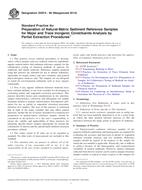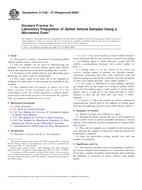Potřebujeme váš souhlas k využití jednotlivých dat, aby se vám mimo jiné mohly ukazovat informace týkající se vašich zájmů. Souhlas udělíte kliknutím na tlačítko „OK“.
ASTM E203-08
Standard Test Method for Water Using Volumetric Karl Fischer Titration
Automaticky přeložený název:
Standardní zkušební metoda pro vodu metodou objemového Titrace podle Karl Fischera
NORMA vydána dne 1.10.2008
Informace o normě:
Označení normy: ASTM E203-08
Poznámka: NEPLATNÁ
Datum vydání normy: 1.10.2008
Kód zboží: NS-44019
Počet stran: 10
Přibližná hmotnost: 30 g (0.07 liber)
Země: Americká technická norma
Kategorie: Technické normy ASTM
Kategorie - podobné normy:
Anotace textu normy ASTM E203-08 :
Keywords:
free water, Karl Fischer reagent, pyridine-free, volumetric, water, water of hydration, Karl Fischer reagent method--water content, Liquids--laboratory applications, Organic compounds--water, Solid phase materials, Water content--chemicals, ICS Number Code 71.040.40 (Chemical analysis)
Doplňující informace
| Significance and Use | ||||||||||||||||||||||||||||||||||||||||||||||||
|
Titration techniques using KF reagent are one of the most widely used for the determination of water. Although the volumetric KF titration can determine low levels of water, it is generally accepted that coulometric KF titrations (see Test Method E 1064) are more accurate for routine determination of very low levels of water. As a general rule, if samples routinely contain water concentrations of 500 mg/kg or less, the coulometric technique should be considered. Applications can be subdivided into two sections: (1) organic and inorganic compounds, in which water may be determined directly, and (2) compounds, in which water cannot be determined directly, but in which interferences may be eliminated by suitable chemical reactions or modifications of the procedure. Further discussion of interferences is included in Section 5 and Appendix X2. Water can be determined directly in the
presence of the following types of compounds:
Note 1—Some acids, such as formic, acetic, and adipic acid, are slowly esterified. For high accuracy with pyridine-based reagents, use 30 to 50 % pyridine in methanol as the solvent. When using pyridine-free reagents, commercially available buffer solutions can be added to the sample prior to titration. With formic acid, it may be necessary to use methanol-free solvents and titrants (1). Note 2—Examples of stable aldehydes are formaldehyde, sugars, chloral, etc. Formaldehyde polymers contain water as methylol groups. This combined water is not titrated. Addition of an excess of NaOCH3 in methanol permits release and titration of this combined water, after approximate neutralization of excess base with acetic acid (see Note 9). Note 3—Weak amines are considered to be those with Kb value <2.4 × 10−5. Note 4—Examples of stable ketones are diisopropyl ketone, camphor, benzophenone, benzil, dibenzolacetone, etc. Note 5—Sulfuric acid up to a concentration of 92 % may be titrated directly; for higher concentrations see Note 13. Note 6—Compounds subject to oxidation-reduction reactions in an iodine-iodide system interfere. |
||||||||||||||||||||||||||||||||||||||||||||||||
| 1. Scope | ||||||||||||||||||||||||||||||||||||||||||||||||
|
1.1 This test method is intended as a general guide for the application of the volumetric Karl Fischer (KF) titration for determining free water and water of hydration in most solid or liquid organic and inorganic compounds. This test method is designed for use with automatic titration systems capable of determining the KF titration end point potentiometrically; however, a manual titration method for determining the end point visually is included as Appendix X1. Samples that are gaseous at room temperature are not covered (see Appendix X4). This test method covers the use of both pyridine and pyridine-free KF reagents for determining water by the volumetric titration. Determination of water using KF coulometric titration is not discussed. By proper choice of the sample size, KF reagent concentration and apparatus, this test method is suitable for measurement of water over a wide concentration range, that is, parts per million to pure water. 1.2 The values stated in SI units are to be regarded as standard. 1.3 This standard does not purport to address all of the safety concerns, if any, associated with its use. It is the responsibility of the user of this standard to establish appropriate safety and health practices and determine the applicability of regulatory limitations prior to use. Specific warnings are given in 3.1 and 7.3.3. 1.4 Review the current Material Safety Data Sheets (MSDS) for detailed information concerning toxicity, first aid procedures, and safety precautions for chemicals used in this test procedure. |
||||||||||||||||||||||||||||||||||||||||||||||||
| 2. Referenced Documents | ||||||||||||||||||||||||||||||||||||||||||||||||
|
||||||||||||||||||||||||||||||||||||||||||||||||
Podobné normy:
Historická
1.1.2014
Historická
1.10.2013
Historická
1.10.2013
Historická
1.6.2008
Historická
1.5.2011
Historická
1.5.2011
Doporučujeme:
EviZak - všechny zákony včetně jejich evidence na jednom místě
Poskytování aktuálních informací o legislativních předpisech vyhlášených ve Sbírce zákonů od roku 1945.
Aktualizace 2x v měsíci !
Chcete vědět více informací? Podívejte se na tuto stránku.



 ASTM D5074-90(2014)..
ASTM D5074-90(2014).. ASTM D5085-02(2013)..
ASTM D5085-02(2013).. ASTM D5086-01(2013)..
ASTM D5086-01(2013).. ASTM D5166-97(2008)e..
ASTM D5166-97(2008)e.. ASTM D5544-11
ASTM D5544-11 ASTM D5788-95(2011)..
ASTM D5788-95(2011)..
 Cookies
Cookies
